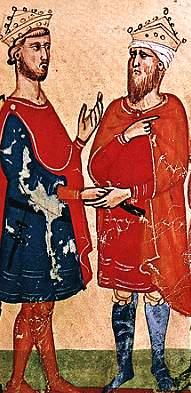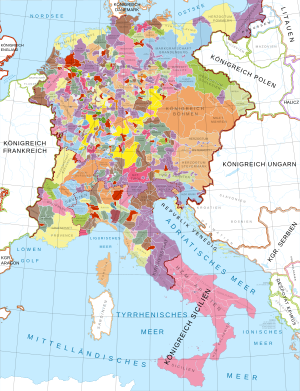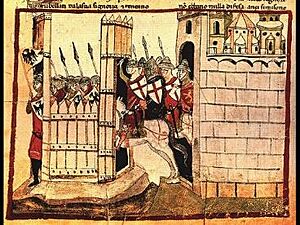Frederick II, Holy Roman Emperor facts for kids
Quick facts for kids Frederick II |
|
|---|---|
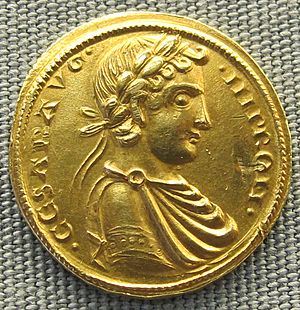
A gold augustalis coin with Frederick's picture
|
|
| Reign | 23 November 1220 – 13 December 1250 |
| Coronation |
|
| Predecessor | Otto IV in 1215 |
| Successor | Henry VII in 1312 |
| King of Sicily | |
| Reign | 1198–1250 |
| Coronation | 3 September 1198 (Palermo) |
| Predecessor | Constance I |
| Successor | Conrad I |
| Co-ruler | Constance I (1198) and Henry II (1212–1217) |
| King of Jerusalem | |
| Reign | 1225–1228 |
| Coronation | 18 March 1229, Jerusalem |
| Predecessor | Isabella II |
| Successor | Conrad II |
| Born | 26 December 1194 Jesi, Italy |
| Died | 13 December 1250 (aged 55) Castel Fiorentino, Kingdom of Sicily |
| Burial | Cathedral of Palermo |
| Spouse |
Bianca Lancia
(m. 1246) |
| Issue more... |
|
| House | Hohenstaufen |
| Father | Henry VI, Holy Roman Emperor |
| Mother | Constance, Queen of Sicily |
Frederick II (born 26 December 1194 – died 13 December 1250) was a powerful ruler in the Middle Ages. He was the King of Sicily from 1198, King of Germany from 1212, and Holy Roman Emperor from 1220. He also became King of Jerusalem in 1225.
Frederick was the son of Emperor Henry VI and Queen Constance of Sicily. He belonged to the Hohenstaufen family. He ruled a huge area, from Sicily all the way north to Germany. People called him stupor mundi, which means "the astonishment of the world," because he was so smart and unusual for his time.
Frederick was known for being very interested in science, art, and learning. He spoke six languages and supported poets and scholars. He also made important changes to laws in his kingdom. Even though he was a powerful emperor, he often had disagreements with the Pope.
Contents
Early Life and Becoming King
Frederick was born in Jesi, Italy, on 26 December 1194. His mother, Constance, was 40 years old when he was born. He was first named Constantine, but later his name was changed to Frederick Roger. This name honored his grandfathers and showed his mixed heritage.
When Frederick was just three years old, his father died. He was crowned King of Sicily in 1198. His mother, Queen Constance, became his regent, meaning she ruled for him until he was old enough. After his mother died, Pope Innocent III became his guardian.
Frederick grew up in Palermo, Sicily. He learned many languages, including Greek, Arabic, Latin, and a Sicilian dialect. When he became old enough to rule, his first job was to bring order back to Sicily. Many local nobles had taken control while he was a child.
Becoming Holy Roman Emperor
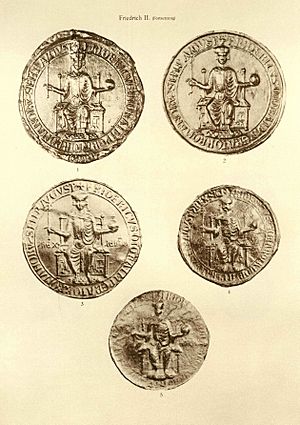
In 1211, Frederick was chosen as the King of Germany by some German princes who were against the current emperor, Otto IV. Frederick traveled to Germany and was crowned king in Mainz in 1212. His power in Germany was not very strong at first.
Otto IV was defeated in a battle in 1214 and died in 1218. This made Frederick the undisputed King of Germany. In 1215, the German princes elected him king again. Finally, after more talks with the Pope, Frederick was crowned Holy Roman Emperor in Rome on 22 November 1220.
Unlike many Holy Roman Emperors, Frederick spent most of his time in Sicily and Italy, not Germany. He visited Germany only a few times after his coronation. His son, Conrad, represented him there.
In Sicily, Frederick made many important changes to the laws. His most famous set of laws was the Constitutions of Melfi (1231). These laws made the Kingdom of Sicily a strong, centralized monarchy. They also set an example for written law, and they were used in Sicily for centuries.
Foreign Policy and Conflicts
The Crusades and Jerusalem

Frederick had promised to go on a Crusade to the Holy Land. He kept delaying his departure, which made the Pope unhappy. In 1225, he married Isabella II of Jerusalem, who was the heiress to the Kingdom of Jerusalem. This marriage made him the King of Jerusalem.
In 1227, Frederick finally set out for the Holy Land, but he got sick and had to return. Because he didn't complete his vow, Pope Gregory IX removed him from the Church (excommunicated him).
Frederick sailed again in 1228, even though he was still excommunicated. This was unusual because excommunicated people were not supposed to lead Crusades. He reached Acre and instead of fighting, he negotiated with the Ayyubid sultan, Al-Kamil.
In February 1229, they signed a treaty. This treaty returned Jerusalem, Nazareth, and Bethlehem to Christian control. However, important Muslim holy sites like the Dome of the Rock remained under Muslim control. The city of Jerusalem also remained without strong walls.
Many other Crusaders and Church leaders were upset by this deal. They felt Frederick had betrayed the Crusader cause by making peace instead of fighting. On 18 March 1229, Frederick crowned himself King of Jerusalem. The Pope lifted Frederick's excommunication in 1230, partly because of the political situation in Europe.
Conflicts with the Pope
Frederick often had disagreements with the Pope. The Pope was worried about Frederick's growing power, especially since Frederick controlled lands both in northern Italy and in Sicily to the south. This meant the Papal States were surrounded by Frederick's territory.
While Frederick was on Crusade, his regent attacked some Papal lands. Pope Gregory IX raised an army and invaded southern Italy. Frederick returned quickly and took back his lands. They made peace with the Treaty of San Germano in 1230.
Frederick also faced a rebellion from his own son, Henry VII, in Germany. Henry was unhappy with his father's policies. Frederick traveled to Germany in 1235 and forced Henry to give up his claim to the crown. Henry was then imprisoned.
Wars in Italy
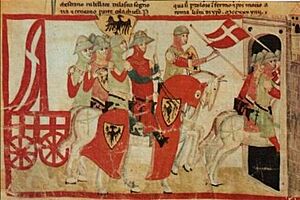
Frederick wanted to restore imperial power in northern Italy, where many cities had become very independent. These cities formed the Lombard League to resist him. In 1237, Frederick won a major victory against the Lombard League at the Battle of Cortenuova. He celebrated this victory like an ancient Roman emperor.
However, the cities of Milan, Brescia, Bologna, and Piacenza continued to resist. Frederick tried to besiege Brescia but failed. In 1239, Pope Gregory IX excommunicated Frederick again. Frederick responded by taking over some lands that belonged to the Papal States.
The conflict continued with battles and sieges. In 1241, Frederick's forces captured a group of Church leaders who were traveling to a council called by the Pope. This stopped the council from happening. Pope Gregory IX died in August 1241.
The Mongol Threat
In 1241, the Mongol Empire's armies invaded Hungary and Poland, causing great destruction. King Béla IV of Hungary asked Frederick for help. Frederick understood the danger the Mongols posed. He ordered his vassals to strengthen their defenses and gather soldiers.
Frederick also sent letters to the kings of England and France, suggesting a Crusade against the Mongols. However, a full-scale Mongol invasion of the Holy Roman Empire never happened, as the Mongols withdrew back to Russia. Frederick then focused on his problems in Italy.
Final Years and Death
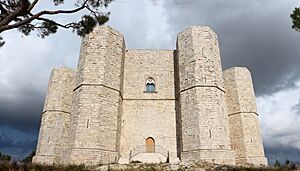
A new Pope, Innocent IV, was elected in 1243. He became Frederick's strongest enemy. In 1245, Innocent IV declared Frederick deposed as emperor. He accused Frederick of being a "friend of Babylon's sultan" and having "Saracen customs."
The Pope supported new kings in Germany to challenge Frederick. Frederick faced many rebellions and battles. In 1247, the important city of Parma rebelled against him. Frederick besieged Parma, building a wooden city called "Vittoria" around its walls.
In February 1248, the rebels attacked Frederick's camp and defeated his army. Frederick lost his imperial treasure. This defeat encouraged more cities to resist him. In 1249, his natural son, Enzo of Sardinia, was captured in battle and remained a prisoner until his death in 1272.
Frederick died peacefully on 13 December 1250, in Castel Fiorentino, Italy, after an illness. He was buried in a porphyry sarcophagus in the Cathedral of Palermo.
After Frederick's death, his family, the Hohenstaufens, lost power. The Great Interregnum followed, a period when there was no clear emperor.
Personality and Interests
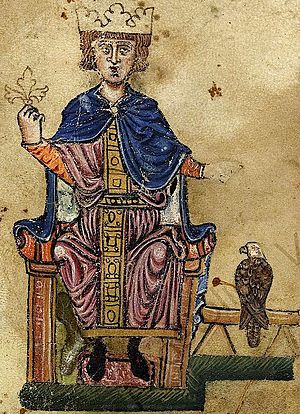
Frederick was known as stupor mundi because he was so unique. He was very curious and loved learning. He was interested in many different cultures and ideas.
He had a special interest in falconry, which is hunting with trained birds. He wrote a famous book about it called De Arte Venandi cum Avibus ("The Art of Hunting with Birds"). He even kept many falconers at his court and asked for special birds from far-off lands.
Frederick also loved exotic animals. His menagerie (animal collection) included giraffes, cheetahs, leopards, and an elephant. He would impress people in northern Italy and Europe with these animals.
He was very interested in science and the stars. His court had many astrologers and astronomers. He often wrote to scholars asking them to solve scientific and mathematical questions.
In 1224, Frederick founded the University of Naples, which is the oldest state university in the world. It is now called Università Federico II. He also supported poets and artists, especially through the Sicilian School of poetry. This school played a big role in the development of the modern Italian language.
Frederick moved the Muslim population of Sicily to Lucera on mainland Italy in 1220. He allowed them to keep their religion and even enlisted some in his army.
Law Reforms
Frederick made important changes to laws. His 1241 Edict of Salerno was very important for medicine. It made a clear separation between doctors and pharmacists. Doctors were not allowed to also be pharmacists, and the prices of medicines were set. This became a model for regulating pharmacy throughout Europe.
In Germany, however, Frederick had to give more power to the German princes. In 1232, he issued the Statutum in favorem principum ("statute in favor of princes"). This gave princes more control over their lands, including the right to make their own laws and coins. This weakened the emperor's power in Germany.
Legacy
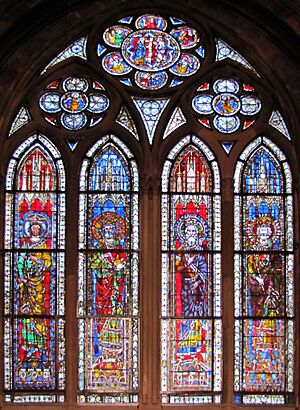
Historians consider Frederick II a very important European monarch of the Middle Ages. He was seen as a Christian ruler who believed he was God's representative on Earth, like the Byzantine emperors. He wanted to continue the idea of the Holy Roman Emperor as the true successor to the ancient Roman Emperors.
Frederick's court was a mix of different cultures, with people from various backgrounds. His decisions, like giving more power to German princes, had a lasting impact on German history. Some historians believe these actions delayed German unity for centuries.
Frederick's tomb is in the Cathedral of Palermo next to his parents and his grandfather, King Roger II of Sicily.
Family
Frederick had many children. Here are his legitimate children:
- With Constance of Aragon:
- Henry (VII) (1211–1242)
- With Yolande of Jerusalem:
- Conrad IV (1228–1254)
- With Isabella of England:
- Henry (1238–1253)
- Margaret (1241–1270)
He also had children with Bianca Lancia, including:
- Constance (Anna) (1230–1307)
- Manfred (1232–1266), who later became King of Sicily.
Frederick also had other children with different mothers.
Images for kids
See also
 In Spanish: Federico II Hohenstaufen para niños
In Spanish: Federico II Hohenstaufen para niños
- Dukes of Swabia family tree
- Family tree of the German monarchs



